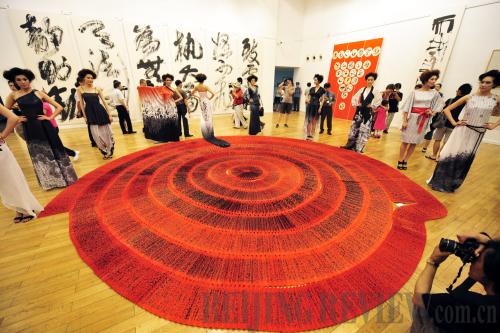|
 |
|
NEW LOOK: An exhibition of modern calligraphy in Hangzhou, Zhejiang Province, on June 20 (LI ZHONG) |
Although I am not a graphic artist, I'm interested in design, especially design pertaining to the written word; that is, fonts and type. In the Western world, several currently popular fonts date back to the advent of the printing press in the 15th century. Some esoteric fonts used by today's artists emulate monks who copied medieval manuscripts by hand.
In China, until recently, most signs written in Latin letters used one of two fonts: MingLui and SimSun; they were imported from a Hong Kong company called Dynalabs. Several years ago, Microsoft developed a "dual font" feature, allowing a variety of Western fonts to be used with Chinese characters. Most of my Chinese colleagues, however, feel little need to differ between fonts such as Times New Roman and Arial. Latin fonts look the same to them.
Perhaps this is due to the incredibly rich Chinese writing tradition based on calligraphy. This means of communication is also an art form established over 1,500 years ago. Chinese calligraphy has served (and continues to serve) as a vehicle of public expression by intellectuals, artists, students and state leaders. Calligraphers here have sought to convey beauty in conjunction with ideas. Their subjects have ranged from expressing concerns directed at the seat of power to rhapsodizing about nature.
Chinese calligraphy not only embodies literacy, but also serves as a way to give voice to emotions, erudition and artistic talent. Its practitioners draw upon a body of work that has many past masters, with each employing his or her unique style. No Western font can compete with this living tradition.
In the past 25 years, calligraphy has again blossomed in China, with avant-garde artists creating modern art via calligraphy. Two major modern artistic directions have emerged: Cutting-edge Chinese artists are fusing calligraphy with modernism, and they're using calligraphy in contemporary works of art. Around 1985, when China began to explode intellectually and creatively, three artists—Huang Miaozi, Gu Gan and Li Luogong—formed the Chinese Society of Modern Calligraphy and Painting. Their work is not traditional. By minimizing textual content, embracing abstract elements, and even adding color and figuration, their movement has created a calligraphic avant garde. Currently, Chinese and Western critics alike are questioning whether calligraphy can evolve and adopt a contemporary appearance while retaining core values.
Wang Tiande, a professor at the China Art Academy in Hangzhou, Zhejiang Province, employs calligraphy in an elegant, ironicand thoroughly modern way. He has worked with fire and photography, making paintings and calligraphy by burning rice paper, stacking it in multiple layers. His work evokes complex patterns, scripts, even landscapes.
Some art critics and artists find contemporary artists disconcerting. Attempts to reinvent calligraphy as "modern art" fail in their eyes. By stylizing the written form, or exaggerating the calligraphic hand, these innovations are viewed as graphic abstract art rather than as true works of calligraphy. It remains to be seen whether today's Chinese artists will fully exploit traditional mores regarding calligraphy.
Historically, Chinese artists used calligraphy collaboratively. They created a dialogue with each other, with successive interpretations by artists through time—making the art an interactive, vital medium of expression. Artists produced works that responded to each other's works—whether it was painted images, poems or commentaries. Critiques and official seals were added to the calligraphic works, which passed from one connoisseur to another over hundreds of years. In this way, the art of collecting fused with artistic critique, giving life and energy for ongoing artistic transformation, as well as providing a channel to reassert traditional values.
The potential of calligraphy remains unlimited. It has already entered into modern art as a new paradigm for artistic practices. Perhaps these avant-gardeists will employ calligraphy via decomposition and deconstruction. Linking text with graphic images has already resulted in complex, engrossing multimedia projects. Anyone interested in art and modern graphic trends should not fail to study the Chinese art scene. Many beautiful books are available in English and Romance languages; Robert Bernell in Beijing has the best Chinese contemporary art bookstores in Asia, if not the world.
Calligraphy is a unique artistic expression little understood by most Westerners. To become adept as a calligrapher requires not only technical excellence but also emotional sensitivity: The artist must be able to feel and reveal ideas and concepts. As China continues to grow and change, Chinese artists are also undergoing powerful transformations. Take time to visit galleries and view shows, for the contemporary Chinese art scene is something well worth viewing and studying.
The author is an American living in Beijing
|
